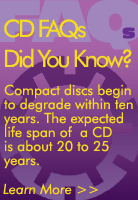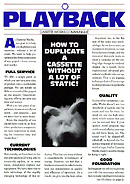|
|
 |
DID YOU KNOW?
How Long Do Compact Discs Last?
Although manufacturers quote studies that predict lifetimes of 20, 50, or even 100 years for a written or manufactured disc, the longevity will no doubt ultimately be limited by the cumulative effects of small scratches and contaminants that are introduced through normal handling and use. The shelf life of an unrecorded disc has been estimated at between 5 and 10 years. And some discs are better than others. There is no standard agreed-upon way to test discs for lifetime viability. Accelerated aging tests have been done under stable conditions, but they do not take into account real-world handling and conditions.
Exposing the disc to excessive heat, humidity, or to direct sunlight will greatly reduce the lifetime. In general, CD-Rs are far less tolerant of environmental conditions than pressed CDs, and should be treated with greater care. The easiest way to make a CD-R unusable is to scratch the top surface. CD's should be kept in a cool, dark, dry place.
Although damage to the readout or bottom surface can cause a disc to fail, the label side is even more delicate. A CD-R dye layer is covered by a thin metallic coating
and then a fragile protective layer. This very thin acrylic or lacquer layer is only 5 to 10 micrometers thick (200 to 400 microinches). Physical damage to this surface will destroy the underlying recorded data, or will admit atmospheric contaminants that corrode the metallic coating. Silver is particularly vulnerable to attack by sulphur, a common air pollutant. Even aluminum layers used for CD-ROM discs oxidize when exposed to clean air, resulting in loss of performance.
|
 |
|


